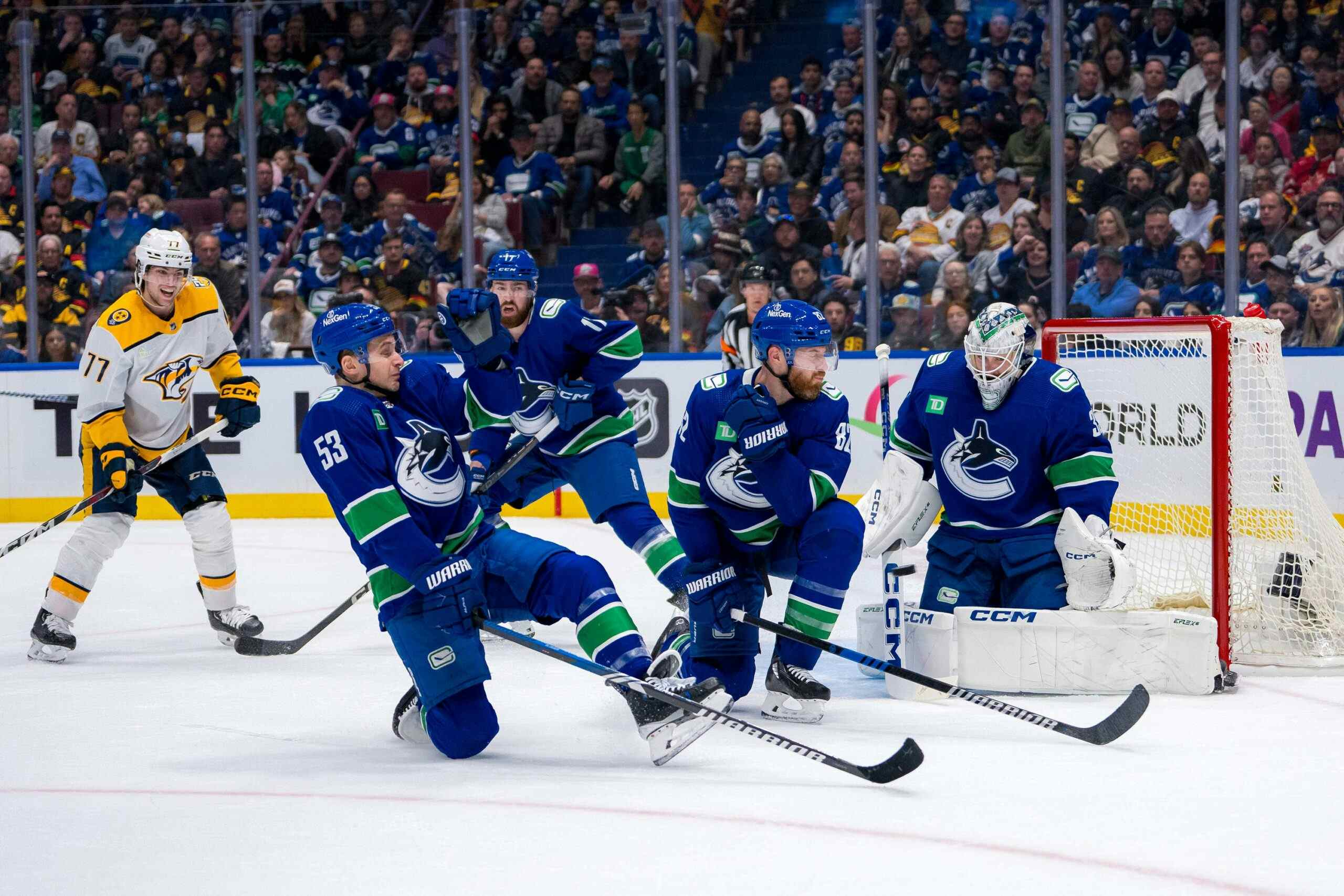Where it Might Make Sense to Increase Hodgson’s Ice-Time
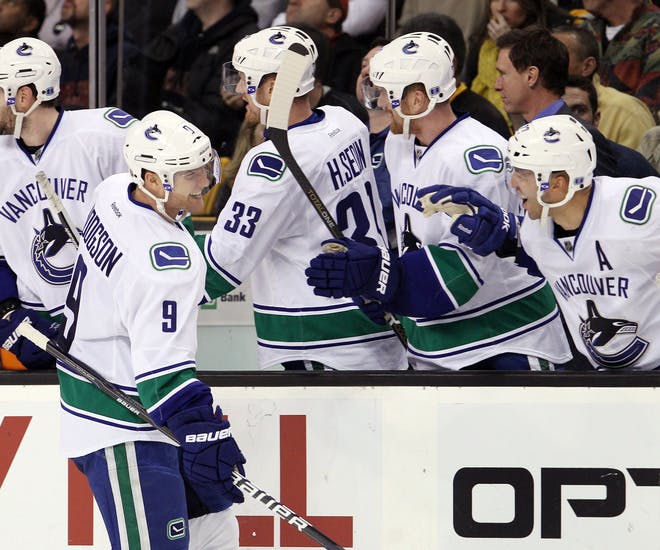
Cody Hodgson is a beast on the power-play.
In the first pre-season game of the 2011-12 season, the Canucks iced two teams: a stronger squad at home against a weak Flames squad, and a bunch of cannon-fodder in Calgary against a stronger Flames team. When Alain Vigneault sent blue-chip rookie Cody Hodgson to the chopping block in Calgary with the likes of Steve Begin and Darren Archibald, the "Vigneault hates Hodgson" meme took off. This school of thinking has continued in earnest throughout the season, and has taken the form of obsessive critiquing of the way the Canucks head-coach deploys the rookie. The hand-wringing reared its head again last night when Hodgson didn’t receive a single shift in over-time.
For the most part, I’ve found this common obsession with Hodgson’s ice-time to be a bit confusing. Under the tutelage of Alain Vigneault, Canucks fans have seen Henrik and Daniel go from point-per game players to regular Art Ross contenders. We’ve watched as fringe prospects like Bieksa, Hansen and Burrows became productive every day NHLers. All the while, Ryan Kesler morphed into a forty goal scorer, and Alex Edler became an All-Star. Yet we’re insisting that Vigneault has lost the ability to develop young hockey players? It just doesn’t pass the smell test.
As Daniel Wagner pointed out, rookie’s minutes are often closely controlled without damaging the skater’s long-term developmental curve, and anyways Hodgson finds himself in a perfect situation to learn from a number of savvy veterans all of whom possess a variety of desirable attributes. Cam Charron has also pointed out that playing Hodgson on the second line (at wing), against more difficult competition than he’s used to, isn’t helping out the rookie or the team.
By the numbers, Cody Hodgson is seventh among all forwards in even-strength ice-time and 9th in even-strength ice-time per game, meaning he’s deployed as a third liner at even-strength. When you’re a rookie centreman playing on a team that has arguably the best 1-2 punch at centre in the entire league, holding down the third line is impressive, and probably as high as you can rise in your first full professional season…
When it comes to power-play ice-time, Hodgson is relied upon a fair bit. He’s fourth among all Canucks forwards in total power-play ice-time, but when it’s averaged out on a per-game basis he slides into 7th. Partly this is because Burrows’ has spent some time playing the point, so he’s squarely on the 2nd unit and based on overall power-play production is the fourth most important Canucks forward with the man-advantage. I don’t mean to second guess Alain Vigneault who I believe to be a very competent, innovative head-coach, but if you were going to point out one phase of the game where perhaps Hodgson deserved to see the ice more, I think the power-play is the place to start.
Before I begin, I relied heavily upon the resources available at Behindthenet.ca and Dobberhockey.com/FrozenPool (which I pay for) to produce this. I highly recommend poking around both those sites, they’ve got a lot of excellent tools to help further one’s understanding of the game.
Based on his rate of production in a bit over half of an NHL season, Cody Hodgson is the most efficient power-play producer on the team. He’s scoring nearly three quarters of a goal more than the next leading forward (Daniel Sedin) per sixty minutes, and at the same rate is posting nearly three quarters of a point more than Henrik Sedin with the man-advantage.
Now, the Sedins have received double the number of power-play minutes that Hodgson has, and that admittedly skews these numbers. I’m not suggesting that Hodgson is the sort of other-worldly force on the power-play that the twins are, but he’s still scary good! To put in perspective just how good (and scary) he’s been: among NHL forwards who’ve received over 90 minutes of power-play ice-time this season, he’s the fourth most efficient scorer behind only Claude Giroux, Teemu Selanne and, somehow, David Legwand.
Despite Hodgson’s power-play proficiency, when Sami Salo went down with a concussion, Vigneault elevated Alex Burrows – who has never been a power-play producer really – to the first unit. Burrows has manned the right point despite being a left-handed shooter, more well known for potting garbage goals than the velocity on his slap-shot. Hodgson on the other hand, is a right handed shooter whose clapper is so deadly doctors call it Gonorrhea.
The usual argument against elevating Hodgson to the first unit states that his presence on the second unit gives the Canucks two worthwhile lines to put out there when they’ve got the man-advantage. The logical conclusion of this argument is that maintaining a somewhat dangerous second unit is more valuable and makes better sense than icing the best possible first unit. The issue with this argument is that the Canucks do not exhibit a balanced pattern of deployment between the first and second units, and as a result Hodgson doesn’t get the opportunity that I’d suggest his production, and potential warrants.
I’ve cooked up some pie-charts to help me make this point. During the 2009-10 season, before Kesler was permanently joined with the Sedin twins on the "loaded first unit", he played pivot on a productive second power-play line. Vigneault used that second power-play group quite a bit, resulting in an equitable distribution of ice-time between the 1st and 2nd power-play units:

Vigneault’s "balanced" approach to the power-play was effective, and the Canucks scored the third most power-play goals in the league that season, while capitalizing on 20.9% of their opportunities (good for sixth in the NHL).
The next season saw some changes in the way the Canucks deployed 5-on-4, and the lions share of the credit goes to Newell Brown and his "loaded" approach to the Canucks power-play. Newell Brown combined the team’s top-3 forwards (Kesler and the twins) and relied on them heavily to produce offense. Brown and the Canucks basically turned the 2nd power-play unit into an honorary group, who were barely used except to spell the 1st unit when the twins and Kesler got tired:
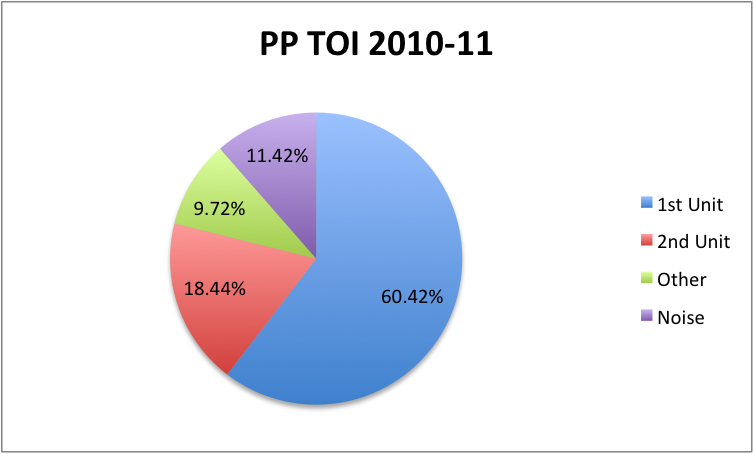
If you’re reading this blog you know how good the Canucks power-play was last season, they were first in the league by a wide margin in both total power-play goals and in capitalization percentage. While this strategy punched up the power-play overall, it meant the second unit was left without an offensively gifted centreman (Manny Malhotra was the most frequently used 2nd unit centre last season). As a result, the Canucks become extremely reliant on their first power-play group, who accounted for 78% of the team’s power-play goals:
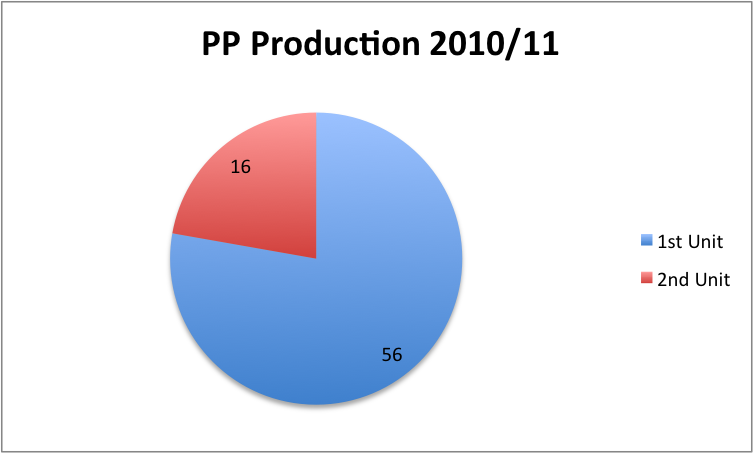
So now that we know what it looks like when a team "loads up" on their first power-play unit, let’s see how the Canucks have deployed their power-play lines this season:
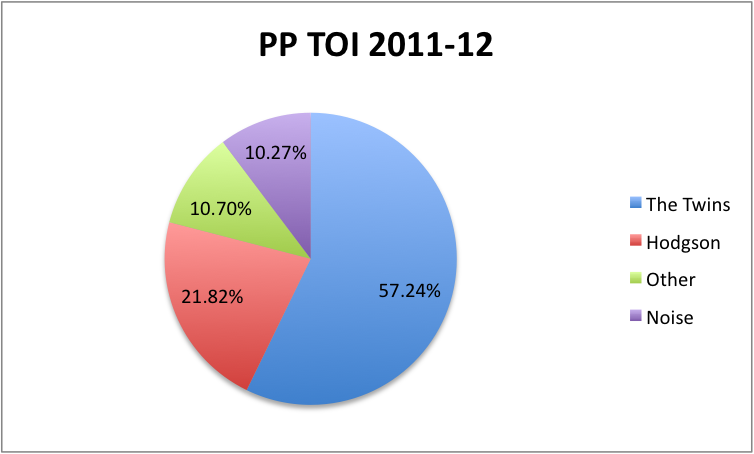
For all intents and purposes, it’s functionally the same deployment pattern the team used the season previous. Broken down on a per opportunity basis, the twins are receiving three seconds less per power-play this season than they did last season, and the second unit is receiving an average of four seconds more per opportunity.
The difference, however, is that the second unit, led by Hodgson who has been in on 66% of the 2nd units goals, have been able to provide the first unit with significantly more relief (in terms of production) than they enjoyed last season:
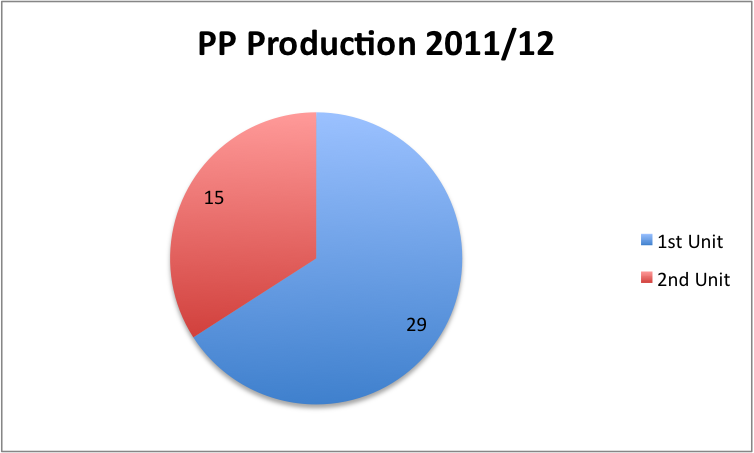
The second power-play unit has basically already matched the total output of last season’s second unit, and there’s well over thirty games left to play in the season! The first unit is now scoring only 66% of the team’s power-play goals, still a massive chunk, but despite the continuation of the "loaded" approach when it comes to parcelling out ice-time, it’s fair to characterize this years power-play as "more balanced" than it was last season.
Look, the same rule that applies to George Frideric Handel’s Operas applies here: if it ain’t baroque don’t fix it. The Canucks have scored six more power-play goals then the next most productive power-play team, and are capitalizing at a rate over 2% higher than the next closest squad. But with Salo’s injury opening up a slot on the first unit power-play, the Canucks have decided to go with Alex Burrows over the 4th most efficient power-play scorer in the NHL. Considering the limited way the team uses their second unit, and the negligible impact a more productive second unit has had on the team’s overall power-play percentage, I’d suggest to you that it’s a minor mistake.
Hodgson’s minutes at even-strength are appropriate, and I’m not someone who wants to see him blocking shots on the penalty-kill. In fact, I find the criticism of Hodgon’s ice-time to be extremely annoying, borderline irrational and driven mostly by a general dislike of Alain Vigneault among some fans and media members in the Vancouver market. Nonetheless, Cody Hodgson has shown enormous promise as a point producer on the power-play, and I’d very much like to see that promise nurtured further. I’d also really enjoy watching him take point-shots with that Megaman cannon of his.
Recent articles from Thomas Drance



